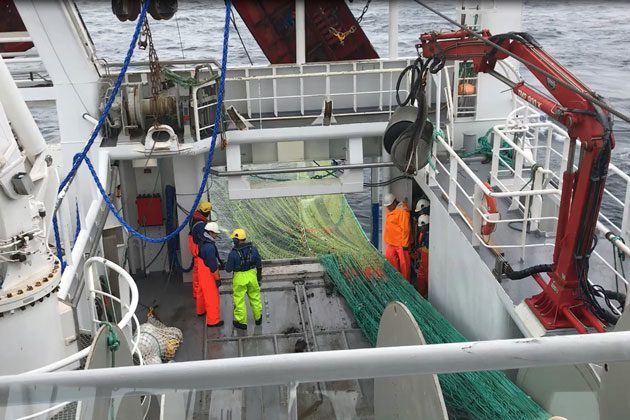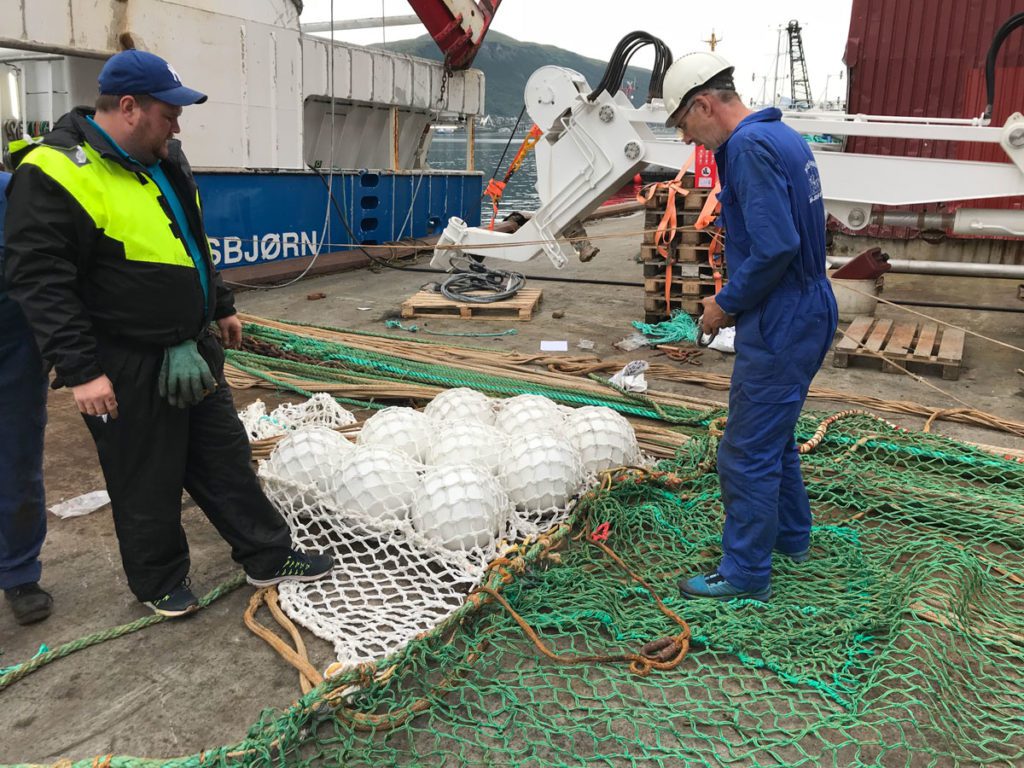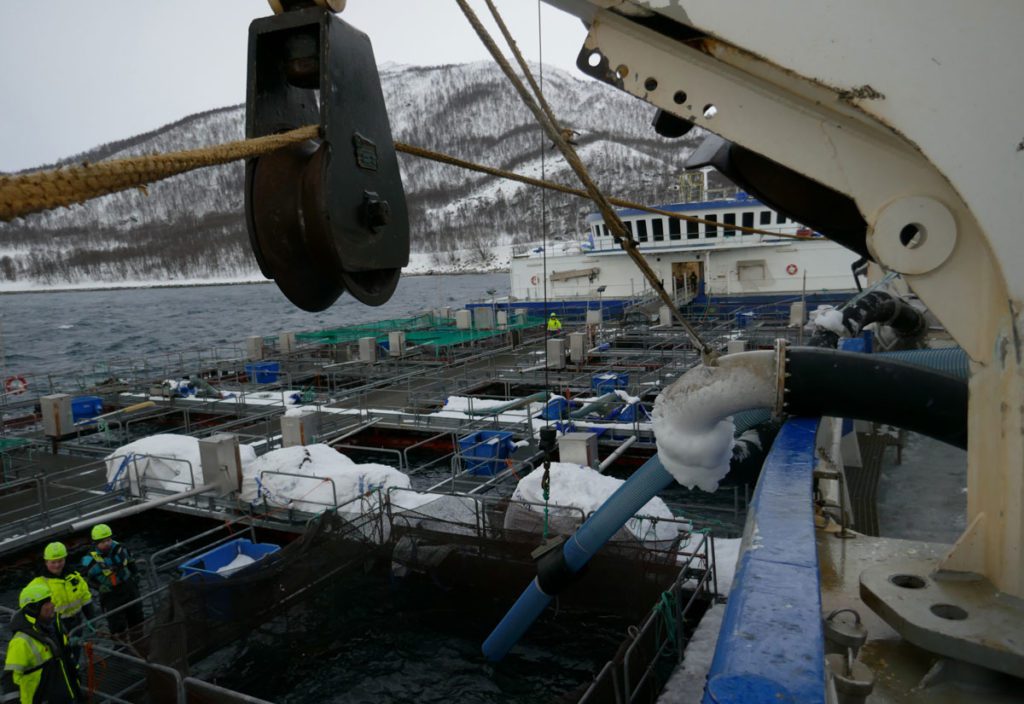Testing pelagic trawl for wild catch of cod

Can pelagic trawls be used to catch cod for live storage? Nofima has been on a journey to find answers in collaboration with the coastal fishing company Asbjørn Selsbane and the Norwegian Institute of Marine Research.
Senior researcher Gustav Martinsen is full of praise for Asbjørn Selsbane and the company’s general manager Andreas Hansen: They are an important driving force, and have participated with significant resources to carry out the research.
Hansen himself comments on it in this way:
– I think the trawlers will develop live catch techniques even more in the next five to ten years. The condition of the fish when it comes on board has a lot to say for the quality of the fish products. All change is difficult and costly to implement. Taking units out of commercial fishing and assigning them to the test is challenging, but we believe in the development of the industry and that this can be a new way of doing things.
Desire from the industry
It is a desire of the industry to be able to catch live cod more year-round, and not only when it has access to land. The reason is, among other things, that it is demanding and expensive to keep the cod in cages for several months. After the spring fishing, the fish are usually left in cages throughout the summer and parts of the autumn.
– We at the fishing company Asbjørn Selsbane AS want to develop our fishing methods more, and we have several reasons to want to test pelagic trawling as a possible tool for catching live cod, says general manager Andreas Hansen.

Economy, environment and fish welfare
Economics, fish welfare and environmental protection have all been key factors, as well as more innovation related to fishing equipment.
The project “Pelagic/semi-pelagic trawl 2018-2021” started with the theory that pelagic trawling is more gentle on the seabed than the usual bottom trawling. In addition, the use of trawls versus Danish seine involves less plastic in the sea. Danish seine lines have until now been the preferred method for live fishing, but it requires around four kilometres of line to be set out. The lines are made of plastic and wear down for each haul. The trawl has steel wires and thus does not contribute in the same way with regard to the release of plastic.
– We envisioned that with the help of trawls with weights and trawl doors, we could also achieve a more controlled ascent of the catch. This is more difficult when using Danish seine. Details during the haul determine whether the bag reaches the surface quickly, or whether it sinks so that you can let the fish recover in stages on the way up, Hansen explains.
– If it is full of fish so that you can make short hauls, then the trawl technology should be just as good and sometimes even better than Danish seine, he believes.
– Traditional bottom trawls are normally towed by the vessel between two and five hours before they are taken up, and this is not ideal for live fishing. With shorter towing time, trawlers will also be able to catch live fish, but this will affect the catch efficiency. The time for a Danish seine haul varies. The fish are often collected and caught within 30-45 minutes. Shorter catch times result in significantly less tired fish, which provides better survival rates for live catches, explains senior researcher Gustav Martinsen at Nofima.
Three expeditions available
Both Nofima and the Institute of Marine Research have participated in the project together with Asbjørn Selsbane AS. The Norwegian Directorate of Fisheries gave permission for a total of three expeditions in the Barents Sea with pelagic trawls. This trawl is normally used on pelagic fish that live in open bodies of water, such as herring and mackerel.
Three expeditions of one week each were carried out, one in 2018 in the Barents Sea, one in 2019 at Hopen off Svalbard and one in 2021 at Sørøya and off North Troms.
– Environmentally, this was not a success if you count the diesel consumed versus the amount of catch, says Olafur Arnar Ingólfsson at the Institute of Marine Research, who among other things researches fishing equipment. His role was to check that the size selection and catch limitation were in place as required by the Directorate of Fisheries.
In order to get the fish, they eventually obtained permission to go closer to land. They also tried to fish closer to the seabed, and used semi-pelagic trawls. A pelagic trawl with a Danish seine net was used.
The largest trawl haul was 25 tonnes, and thus far above what you want to get in live fishing, while most were between two and eleven tonnes. The fish in the small hauls were in very good condition when they were brought up, while there was a higher mortality rate in the large trawl haul.
– Some of the cod from the final days of the last two expeditions were delivered to Nofima’s live fish facility in Skulgambukt. We kept it here for four weeks, which is the time it can be kept before it has to be fed. It had some mortality immediately after it arrived, but after 2-3 weeks there was no mortality in the catch. Our focus in the project has been the catching method, and how this affects the fish and the quality, Martinsen explains.

Control the trawl doors
Normally, trawlers do not catch the fish alive, but a change is underway. Many trawlers are now trying to get the fish alive before they slaughter it in their own factory.
He has recently been to the fishing fair Danfish in Aalborg, and got to go out with a 15 metre trawler.
– We were able to demonstrate how it was possible to control the trawl doors from the ship effectively. We could position the trawl doors so that they automatically stayed, for example, 2.5 metres above the bottom, he says.
The way forward in our own research expeditions has not yet been determined.
– I still have good faith in this project, even though there are still many questions that remain unanswered and we have not been able to prove our theories in practice in large series. But ground-breaking work is difficult and expensive, and driving development requires goodwill at many levels. Both the authorities, the administration and the industry must want this development, and many factors need to be in place. There is a debate today about where the industry itself wants to be, because it has become so fragmented in terms of boat sizes and groupings, but the field is very exciting anyway, says Andreas Hansen.
Contact person
Research areas
Capture fisheries
Research facilities
